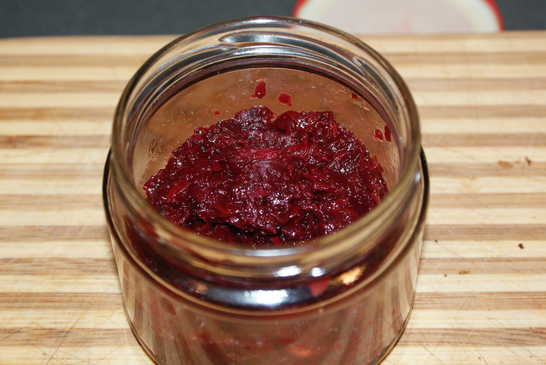
Coffee, Chocolate & Fishy Duck

The duck's not really fishy of course Wait a minute - is that an idea? Fishy duck? No. No, it really isn't. Of course not. As you were... it's just the first course that's fishy.
But the duck is coffee-ey and chocolate-ey.
There were quite a few inspirations for this meal - it's been such a long time since I did any cooking what with running up and down to visit poor old Mum in the hospice (Moominmamma - as my good friend Becky called her), that I suppose I've had a lot of these ideas rattling around in my head.
The fish course comes straight from The Star Inn (a handy watering hole on my trips South) where I had soused mackerel packed in a little jam jar with a beetroot relish.
Delicious.
It wasn't until I made the version below that I realised theirs was more like a raw pickling method than this cooked one, but mine was nice enough for all that.
My friend Doctor Jenny once rhapsodised about their braised radishes when she went to visit the venerable Peat Inn and I fancied having a go at them.
I also remember someone else banging on about baking salt-crusted vegetables - apparently it's all the rage on one of those ghastly cooking competition TV shows - Britain's Got Chefs or whatever, so I thought I'd have a go at those too.
But then that set me thinking about what else you might bake crusted in salt (chicken works apparently?), and then naturally onto what else you might use to pack around yer baking goods.
Now it just so happens that I've had a sack of coffee beans rolling around in the bottom of the freezer I've been trying to empty forever now (so I can get a new one), and needed something to do with them other than making coffee.
I'd thought of baking or steaming fish with them, and had more-or-less dismissed the idea of using duck or chicken, especially breasts, because of the problem of them drying out during the roasting.
I mean - who just roasts duck breasts? No one that's who. Well, until now.
The idea of using the coffee beans from frozen to stop the duck drying out seemed like a stroke of genius. Or madness.
Either way I grabbed onto the idea with both hands et voilà: coffee roasted duck breasts are born.
menu
Soused Mackerel
Soused mackerel with dill, beetroot relish and dill oil
starter pickle fish
There seem to be several approaches to pickling or sousing mackerel:
The serving ideas come from Christoffer Hruskova (who marinates his mackerel for only a short time in a much stronger tepid sousing liquid) - thanks Christoffer!
- Pickle the fillets in undiluted vinegar, japanese style.
- Simmer diluted vinegar with vegetables and spices to make the pickling liquor, then either
- cook the mackerel briefly in the liquid and leave to cool
- or cool the (slightly more vinegary) liquid first before pouring over the fish
- Salting or not salting the fillets.
The serving ideas come from Christoffer Hruskova (who marinates his mackerel for only a short time in a much stronger tepid sousing liquid) - thanks Christoffer!
Serves 4
Ingredients
- 3-4 mackerel, filletted
- 150ml rice vinegar
- 200ml water
- a glug mirin
- 1 tsp honey
- 4 slices orange peel
- ½ teaspoon brown mustard seeds, or so
- ½ teaspoon yellow mustard seeds, or so
- a pinch aniseed
- 2 bay leaves
- 1 tsp salt
- 1 carrot, peeled, thinly sliced
- 1 onion, peeled, thinly sliced
- 1 stick celery, thinly sliced
- a pinch - 1 tsp salt to taste
To Serve:- beetroot relish
- buttermilk snow
- ½ cucumber
- bunch of dill
- quality oil for blending
Pickle The Fish:
Gut the fish, lay it on its side and with a sharp knife cut into the body behind the gills until you feel the backbone, then turn the knife and slice along the backbone to cut off the fillet.
Turn the fish over and repeat on the other side.
Trim the fillets, cutting away any fin bones from the edges, and carefully remove all the pin bones from along the centre of the fillet using fish tweezers.
Slice the onions, carrots and celery. Mix with the other ingredients except the fish in a largish pan and bring to a simmer for 10 minutes until the vegetables are starting to soften.
Add the fillets to the pan, cover and continue heating until the pan just returns to a simmer, then turn off and leave to cool.
Cover with clingfilm or carefully pack into a sealed container and keep overnight in the fridge. (They should keep for up to a week. I think you'd be safe keeping it for significantly longer to be honest.)
Make up the beetroot relish and the buttermilk snow
Pickle The Cucumber:
Using a vegetable peeler, start to peel ribbons of cucumber, throw away the first few which will be mostly skin, and then work your way around the cucumber so as to get fat attractively edged slices while avoiding the seedy centre.
Mix the cucumber slices with a handful of washed dill fronds and cover with cider vinegar.
They're best used after an hour or so. You can leave them pickling overnight, but the flavour might be a little strong - you'd be best patting them dry before using and then mixing with, say, apple or mooli slices to ameliorate their flavour.
Gut the fish, lay it on its side and with a sharp knife cut into the body behind the gills until you feel the backbone, then turn the knife and slice along the backbone to cut off the fillet.
Turn the fish over and repeat on the other side.
Trim the fillets, cutting away any fin bones from the edges, and carefully remove all the pin bones from along the centre of the fillet using fish tweezers.
Slice the onions, carrots and celery. Mix with the other ingredients except the fish in a largish pan and bring to a simmer for 10 minutes until the vegetables are starting to soften.
Add the fillets to the pan, cover and continue heating until the pan just returns to a simmer, then turn off and leave to cool.
Cover with clingfilm or carefully pack into a sealed container and keep overnight in the fridge. (They should keep for up to a week. I think you'd be safe keeping it for significantly longer to be honest.)
Make up the beetroot relish and the buttermilk snow
Pickle The Cucumber:
Using a vegetable peeler, start to peel ribbons of cucumber, throw away the first few which will be mostly skin, and then work your way around the cucumber so as to get fat attractively edged slices while avoiding the seedy centre.
Mix the cucumber slices with a handful of washed dill fronds and cover with cider vinegar.
They're best used after an hour or so. You can leave them pickling overnight, but the flavour might be a little strong - you'd be best patting them dry before using and then mixing with, say, apple or mooli slices to ameliorate their flavour.
Make up the Dill Oil:
Blanch a generous handful of dill briefly in boiling water.
Pat dry.
Blend with oil I used avocado oil which works nicely, you could use rapeseed, and walnut oil is also nice and a dash or two of white wine or cider vinegar.
Season and set aside.
To Serve:
Make a bed of thinly-sliced red onion, dab a couple of fillets dry with kitchen roll and lay on top of the onion, add a pile of beetroot relish (which goes really well with the fish). Using a vegetable peeler cut ribbons of apple, briefly douse them in the dill vinegar from the pickled cucumber (to stop them browning) then arrange the cucumber and apple strips with a little dill leaf decoration. Scatter with buttermilk snow, drizzle over a few drops of dill oil and serve.
Blanch a generous handful of dill briefly in boiling water.
Pat dry.
Blend with oil I used avocado oil which works nicely, you could use rapeseed, and walnut oil is also nice and a dash or two of white wine or cider vinegar.
Season and set aside.
To Serve:
Make a bed of thinly-sliced red onion, dab a couple of fillets dry with kitchen roll and lay on top of the onion, add a pile of beetroot relish (which goes really well with the fish). Using a vegetable peeler cut ribbons of apple, briefly douse them in the dill vinegar from the pickled cucumber (to stop them browning) then arrange the cucumber and apple strips with a little dill leaf decoration. Scatter with buttermilk snow, drizzle over a few drops of dill oil and serve.
Now is that classy or what? Tastes great too!
Coffee Bean Roasted Duck Breasts with a Chocolate and Madeira Sauce
main fowl
So the idea I had here was to roast a breast of duck on a layer of frozen coffee beans
so as to keep the flesh cool and moist allowing the skin to crisp up without drying out the whole fillet.
And of course to infuse the breasts with coffee flavour.
Worked pretty well I thought, and my dinner guest said they were the most tender breasts she'd ever had!
And of course to infuse the breasts with coffee flavour.
Worked pretty well I thought, and my dinner guest said they were the most tender breasts she'd ever had!
Serves 2
Ingredients
- 1 duck breast or two if you're really hungry
- small bag of frozen coffee beans
- 2 brown onions finely sliced
- ½ cup of Madeira
- ½ cup veal or beef demi-glace
- 5g grated bitter chocolate (90%)
- 2 slices of brioche
- 1-2 portions buttered spinach and samphire
To Serve:- horseradish sauce
- salt-baked beets
- braised radishes
First of all, at least half an hour before you want to start the duck, start cooking the beets and radishes in a Gas 6 oven.
Blanch the samphire, wash the spinach, slice the onions so everything is ready to go (you can start frying the onions too if you like).
Keep the duck breasts in the fridge until required.
Keep the duck breasts in the fridge until required.
Score the breasts and rub with salt and pepper.
Preheat the oven to the max.
Fill a chilled oven-proof dish with frozen coffee beans.
Press the duck breast, skin-side up, still chilled, into the coffee beans so only the skin shows, and put in the oven. Skewer with your meat thermometer probe if you have one :) The bottom of the breasts should be the rarest part.
Roast at maximum heat for about 10 minutes until the duck fat begins to sizzle or you smell burning coffee, then turn the heat down to Gas 7/220°C for 15 more minutes or until its internal temperature reaches 50°C. Wrap in foil and rest for 5 minutes.
Meanwhile - make the chocolate sauce:
Gently fry a thinly sliced onion in butter until nicely caramelised.
Pour in the Madeira and the demi-glace or stock.
Strain (if required), then reduce the sauce by about half to thicken.
Finally whisk in the butter a piece at a time until the sauce is rich and glossy, must admit, if the sauce is rich enough you don't really need to add the butter then beat in the grated chocolate.
Season and keep warm.
Heat a generous knob of butter in a frying pan until foaming and fry the brioche slices thoroughly on each side until golden brown. Remove and drain on kitchen paper.
To serve, ladle some of the sauce onto a plate, place the brioche slice, cover with spinach and samphire and top with the duck.
Decorate with a smear of horseradish sauce you could probably use crème fraîche with a touch of wasabi instead, braised radishes, salt-baked beets and game chips or whatever else takes your fancy. Why not sprinkle the plate with a grating of bitter chocolate and throw on a few chocolate-coated coffee beans too for good measure!
Preheat the oven to the max.
Fill a chilled oven-proof dish with frozen coffee beans.
Press the duck breast, skin-side up, still chilled, into the coffee beans so only the skin shows, and put in the oven. Skewer with your meat thermometer probe if you have one :) The bottom of the breasts should be the rarest part.
Roast at maximum heat for about 10 minutes until the duck fat begins to sizzle or you smell burning coffee, then turn the heat down to Gas 7/220°C for 15 more minutes or until its internal temperature reaches 50°C. Wrap in foil and rest for 5 minutes.
Meanwhile - make the chocolate sauce:
Gently fry a thinly sliced onion in butter until nicely caramelised.
Pour in the Madeira and the demi-glace or stock.
Strain (if required), then reduce the sauce by about half to thicken.
Finally whisk in the butter a piece at a time until the sauce is rich and glossy, must admit, if the sauce is rich enough you don't really need to add the butter then beat in the grated chocolate.
Season and keep warm.
You can just cut the onion in half and fry the cut sides in the pan of you want to save time -
it will take about half an hour or so to caramelize the sliced onion,
and that's if you add a little bicarbonate of soda and a teaspoonful of sugar.
You don't want too much chocolate flavour - just a hint is perfect.
Cut fat slices of brioche and trim them to the size of the duck breasts, if you're fussy about such things.You don't want too much chocolate flavour - just a hint is perfect.
Heat a generous knob of butter in a frying pan until foaming and fry the brioche slices thoroughly on each side until golden brown. Remove and drain on kitchen paper.
To serve, ladle some of the sauce onto a plate, place the brioche slice, cover with spinach and samphire and top with the duck.
Decorate with a smear of horseradish sauce you could probably use crème fraîche with a touch of wasabi instead, braised radishes, salt-baked beets and game chips or whatever else takes your fancy. Why not sprinkle the plate with a grating of bitter chocolate and throw on a few chocolate-coated coffee beans too for good measure!
Just fabulous.
Really, really good. Quite a novel way of cooking the duck breasts and infusing them with coffee flavour though I say so myself. (My invention - mine, mine!)
The breasts come out surprisingly evenly cooked, and quite beautifully succulent, if not quite as nice as when pan-fried since you don't get that golden crispy fat.
You can certainly catch the hint of coffee.
If I had one complaint it's that the brioche is a little too sweet for this dish - be sure to fry it well; though it might be better to use a toasted slice of baguette or other savoury bread. Either that or smear the brioche with paté de foie gras before adding the spinach - Tournedos Rossini styley.
Really, really good. Quite a novel way of cooking the duck breasts and infusing them with coffee flavour though I say so myself. (My invention - mine, mine!)
The breasts come out surprisingly evenly cooked, and quite beautifully succulent, if not quite as nice as when pan-fried since you don't get that golden crispy fat.
You can certainly catch the hint of coffee.
Though I see no reason why you couldn't grill them after resting for a crispy finish?
The chocolate sauce also goes well with baked beetroots, as does the horseradish.If I had one complaint it's that the brioche is a little too sweet for this dish - be sure to fry it well; though it might be better to use a toasted slice of baguette or other savoury bread. Either that or smear the brioche with paté de foie gras before adding the spinach - Tournedos Rossini styley.
Beetroot Relish
veg pickle
Makes a cup or so
Ingredients
- 1-2 medium beetroot, peeled, grated
- 1 apple, peeled, cored, grated
- 1" ginger, peeled, grated
- 1 red onion, grated
- 150-200ml red wine vinegar
- dash balsamic vinegar
- ½ tsp salt
- 1 tsp honey
- 3 allspice berries, ground
- ½ tsp yellow mustard seeds
- ½ tsp brown mustard seeds
Peel, core (as appropriate) and grate the beetroot, apple and onion. Grate the ginger more finely.
Heat a covered frying pan and fry the seeds (in a little oil if you like) until they start jumping and release their aroma.
Put all the ingredients into a larger pot, bring to the boil, and simmer until the beetroot is soft and the liquid reduced and syrupy. 30-40 minutes.
Cool and store in a sealed jar - it should keep for weeks if not months.
Heat a covered frying pan and fry the seeds (in a little oil if you like) until they start jumping and release their aroma.
Put all the ingredients into a larger pot, bring to the boil, and simmer until the beetroot is soft and the liquid reduced and syrupy. 30-40 minutes.
Cool and store in a sealed jar - it should keep for weeks if not months.
Hmmm, not bad. I think it might work better with tomatoes in there - so it's a bit ketchupy.
At least for what I wanted it for - to match the soused mackerel.
At least for what I wanted it for - to match the soused mackerel.
It's a modern fad
Salt-Baked Vegetables
side veg
The salt crust nicely flavours the vegetables, though it's more of a novelty than a culinary revolution.
It works best with salt that's in flakes rather than granules (like kosher or Maldon salt), but in any case needs to be pretty fine.
Whole onions are rather good this way I peeled mine, and apparently you can do the same thing with chicken.
It works best with salt that's in flakes rather than granules (like kosher or Maldon salt), but in any case needs to be pretty fine.
Whole onions are rather good this way I peeled mine, and apparently you can do the same thing with chicken.
Ingredients
- root vegetables (beetroot, parsnips, sweet potatoes, potatoes, carrots, onions...), washed, unpeeled
- egg whites
- fine salt (about 1 cup per egg white)
- herbs or spices optionally as desired
Using your hands, mix the salt and egg whites - add as much salt (or egg whites) as necessary to achieve a mixture like wet sand or cement.
Mix in whatever herbs or spices you fancy - thyme, rosemary, fennel seeds, stuff like that.
Prick the vegetables (remember what your mother told you) and coat them thoroughly with the salt mixture so no surface is uncovered.
As far as possible.
Bake at Gas Mark 6 (200°C) for about an hour until the vegetables are tender.
Crack them open a gentle tap with the back of a knife should do it and serve. Whole or in pieces as you like.
Prick the vegetables (remember what your mother told you) and coat them thoroughly with the salt mixture so no surface is uncovered.
As far as possible.
This takes quite a lot of mixture - at least 1 cup of salt per vegetable.
Bake at Gas Mark 6 (200°C) for about an hour until the vegetables are tender.
Crack them open a gentle tap with the back of a knife should do it and serve. Whole or in pieces as you like.
Good flavour.
If you scrub the peel clean before coating the vegetables you can serve them with their peel on - otherwise it's a bit of a faff. They look kind of cool served in some of their crust - so the guests know that you salt-baked them!
Oh and don't forget to tell them not to try to eat the salt crust. It doesn't taste good.
Isn't that right Flora?
If you scrub the peel clean before coating the vegetables you can serve them with their peel on - otherwise it's a bit of a faff. They look kind of cool served in some of their crust - so the guests know that you salt-baked them!
Oh and don't forget to tell them not to try to eat the salt crust. It doesn't taste good.
Isn't that right Flora?
Braised Radishes
side veg vegan
They're very nice braised - like sweet little turnips actually.
They lose a lot of water so don't cover them too tightly.
They lose a lot of water so don't cover them too tightly.
Ingredients
- radishes
- olive oil (you might try other flavours)
- salt
- liquor or herbs of choice
Wash and top and tail the radishes if necessary,
place in an oven-proof dish, drizzle with olive oil, a sprinkling of salt and a glug of liquor.
I used Genepi, but thought that Vermouth would be alright, or even Grappa.
You might also consider citrus peel, or even oil?
Cover loosely and bake for about an hour at Gas 6 until tender.
They won't change the world, but they're quite tasty.
Could do with figuring out how to intensify their flavour a bit.
You can achieve this by juicing a bunch of radishes and adding this to the baking dish.
Ideally you should then arrange the timing, oven position and foil (un-)covering so that almost all the liquid has cooked off by the time the radishes are tender -
after about 1-1½ hours. After which they're really very good.
You can also cut the radishes into amusing shapes (are cubes amusing?) if you want presentational style points.
You can also cut the radishes into amusing shapes (are cubes amusing?) if you want presentational style points.
Buttered Spinach and Samphire with Lovage
side veg
Lovage has a strong sort of peppery celery flavour that goes well with this dish.
Or at least Andrew Pern seemed to think so.
I guess you could use whatever herbs or spices you think might work. Coriander? Dill? Cumin? Lemon peel.
I guess you could use whatever herbs or spices you think might work. Coriander? Dill? Cumin? Lemon peel.
Serves 1-2
Ingredients
- generous knob of butter
- 100g spinach
- 50g samphire
- a few lovage leaves, sliced
Wash the spinach in three changes of water, remove thick stalks.
Drain the spinach thoroughly - preferably in a salad spinner.
Roughly chop up of about two thirds of the leaves.
Carefully pick over the samphire, pluck away any fibrous stems. Blanch once and set aside.
Slice the lovage leaves.
Heat butter in a pan until foaming then fry the chopped spinach until it collapses. Add the samphire and stir until warmed through.
Add the lovage.
Stir in a few fresh whole spinach leaves and remove from the heat as soon as they begin to wilt; almost immediately.
Carefully pick over the samphire, pluck away any fibrous stems. Blanch once and set aside.
Slice the lovage leaves.
Heat butter in a pan until foaming then fry the chopped spinach until it collapses. Add the samphire and stir until warmed through.
Add the lovage.
Stir in a few fresh whole spinach leaves and remove from the heat as soon as they begin to wilt; almost immediately.
Nice.
Adding the whole spinach leaves at the end just gives the mixture some texture and makes it look pretty.
If you prefer then use all the leaves whole, but stop cooking as soon as the spinach is on the point of wilting so you still retain some leafy quality rather than a creamed spinach mush.
Adding the whole spinach leaves at the end just gives the mixture some texture and makes it look pretty.
If you prefer then use all the leaves whole, but stop cooking as soon as the spinach is on the point of wilting so you still retain some leafy quality rather than a creamed spinach mush.
Buttermilk Snow
veg sauce
A nice little topping idea - I imagine you could use it on all kinds of things, salads, savouries even desserts.
Makes more than you will need!
Ingredients
- ½ tbsp of cornflour
- 50ml of milk
- 250ml of buttermilk
- 1 dash of lemon juice
- 1 pinch of salt
Combine the milk and cornflour in a saucepan, or in the microwave, and whisk over a low heat until the mixture thickens.
Remove from the heat and allow to cool to tepid before adding the buttermilk.
Season to taste with a pinch of salt and lemon juice and mix well. Freeze the mixture in a shallow tray.
Just before serving, remove the buttermilk from the freezer and run through the mix with a fork, so that the buttermilk resembles fine snow
Season to taste with a pinch of salt and lemon juice and mix well. Freeze the mixture in a shallow tray.
Just before serving, remove the buttermilk from the freezer and run through the mix with a fork, so that the buttermilk resembles fine snow
Cool ;)
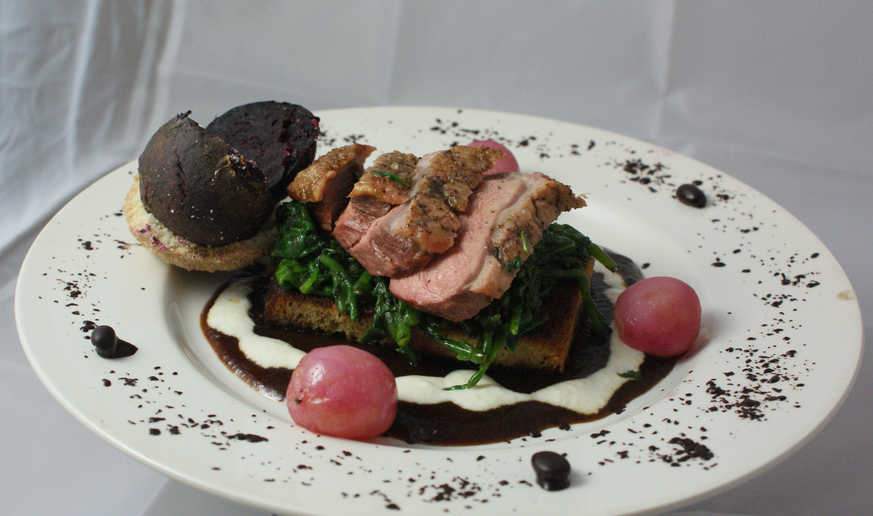

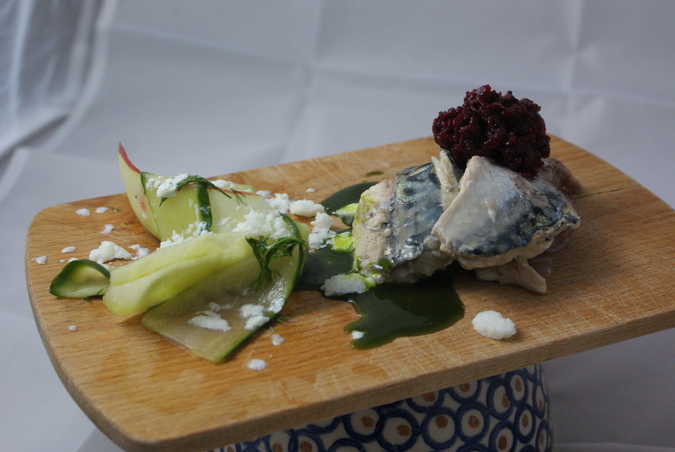
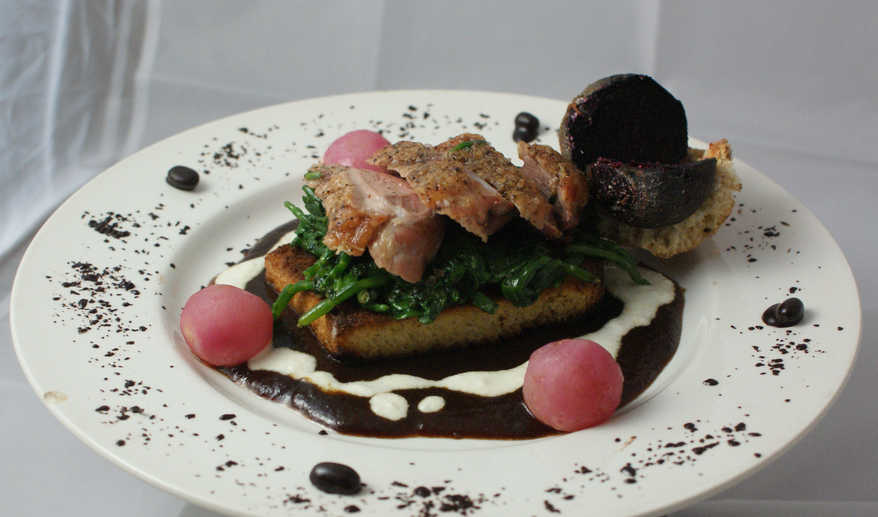
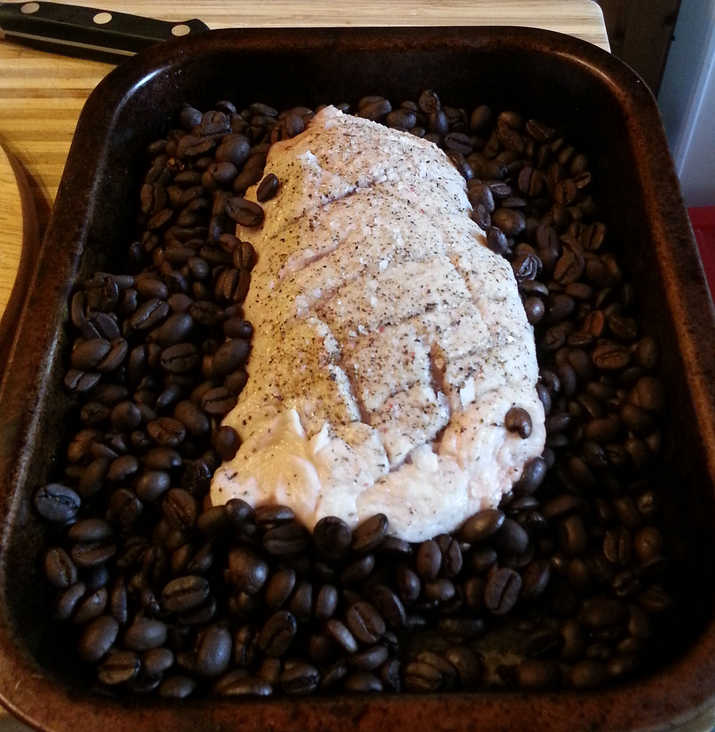
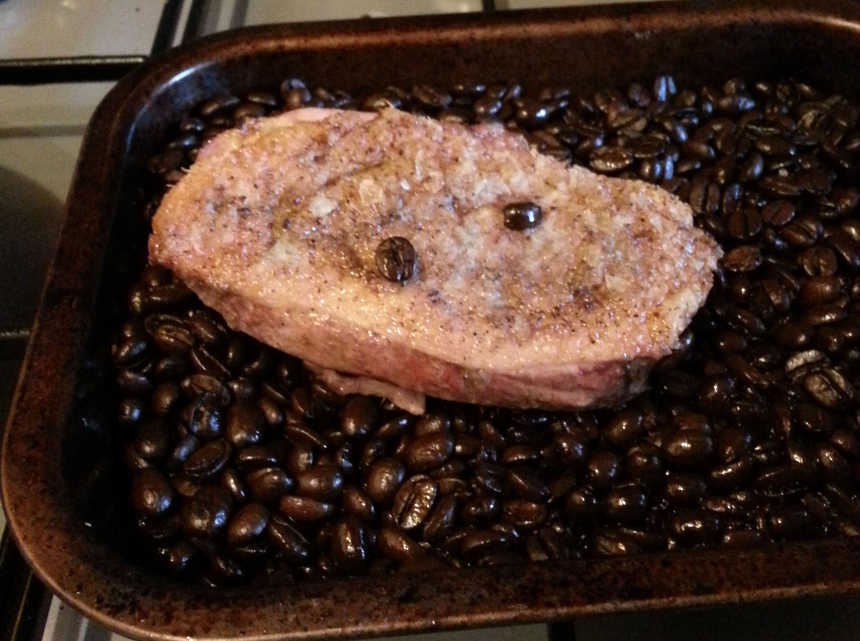
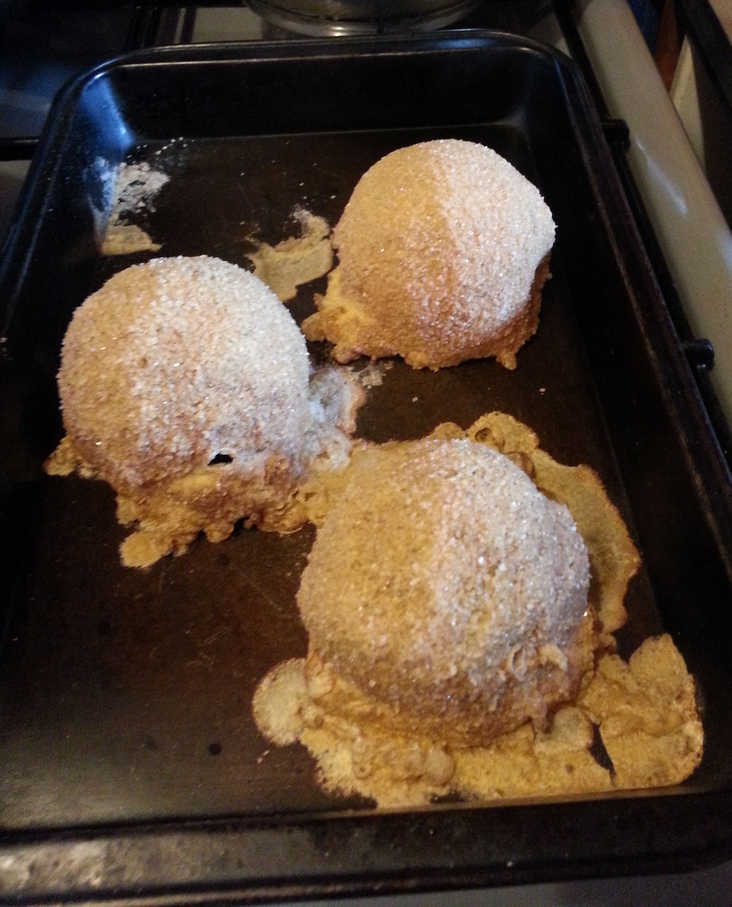
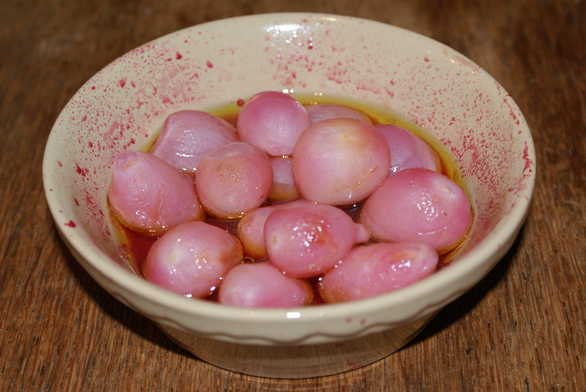
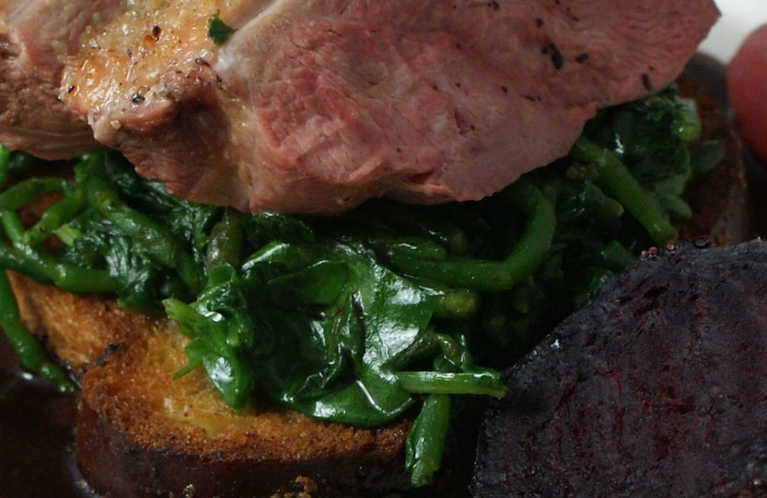
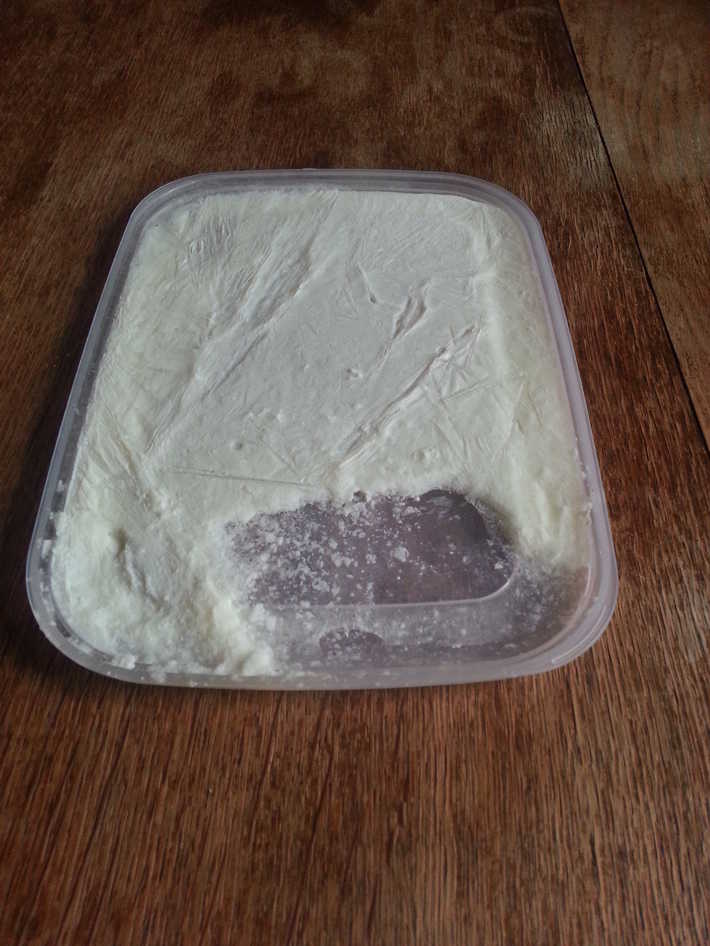
You're welcome.
I think your exact phrase was "spectacular"!
#3 – 13 September, 2013 at 11:13 am
Did I mention it was yummy?
#2 – 12 September, 2013 at 2:53 am
One of my favourite duck dishes ever I am hungry thinking about it. Thank you for cooking it as it was delish.
#1 – 12 September, 2013 at 2:52 am